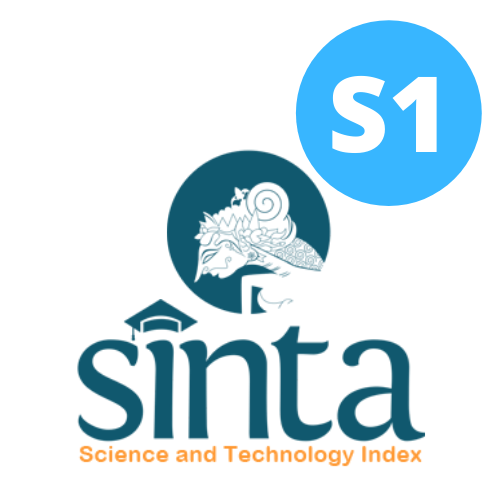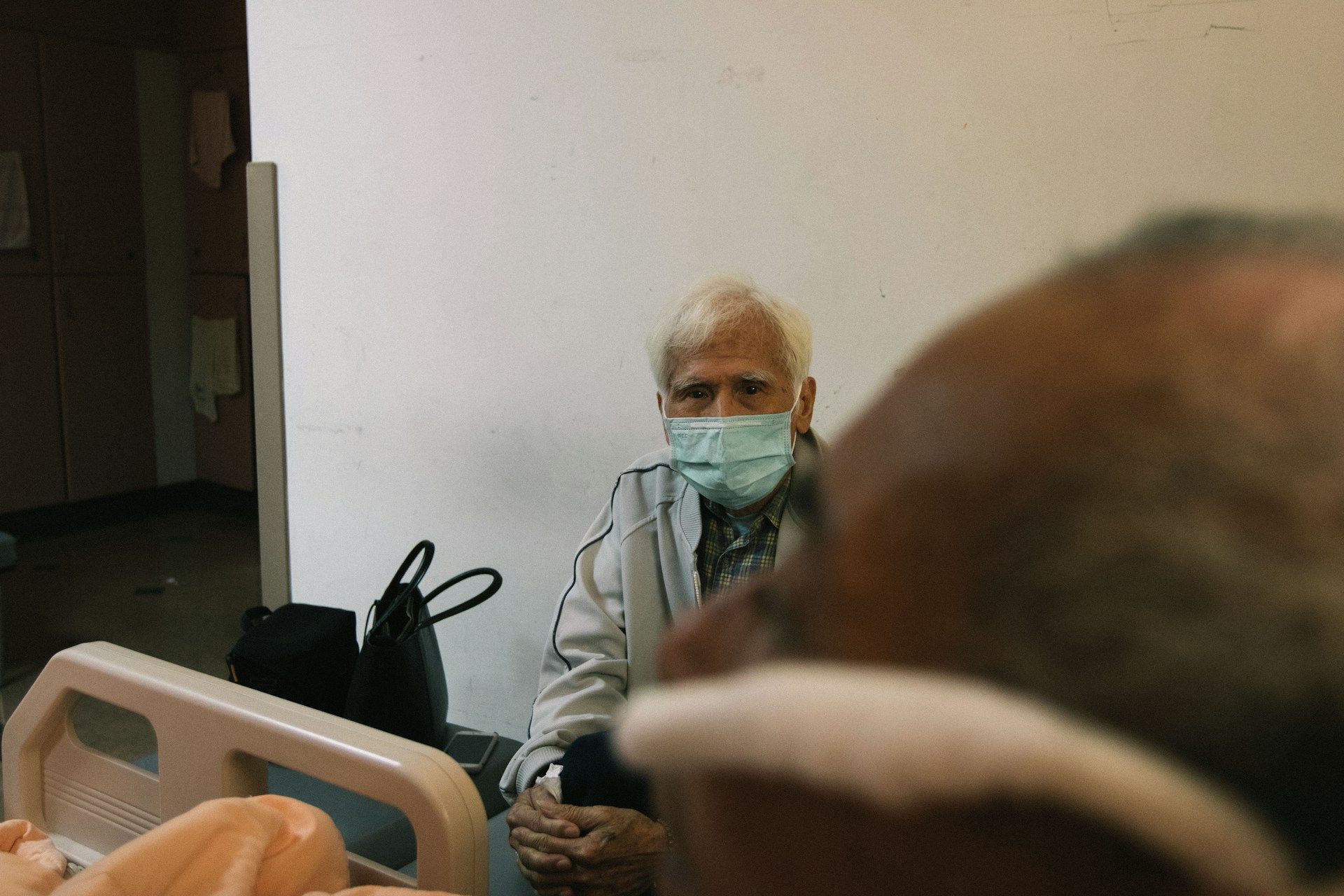Factors Related to Overnutrition among High School Teachers in Bogor City
Faktor-Faktor yang Berhubungan dengan Masalah Gizi Lebih pada Guru Sekolah Menengah Atas di Kota Bogor

Downloads
Background: Teachers play a vital role in education and must maintain productivity. However, some teachers face overnutrition due to spending most of their working hours on low-physical-activity tasks. Previous research in vocational high schools (SMK) in Bogor City reported that 37.3% of teachers were classified as having level I obesity, while 10.7% had level II obesity.
Objectives: This study aims to examine factors associated with overnutrition among senior high school (SMA) teachers in Bogor City and to analyze differences in overnutrition risk factors between public and private schools.
Methods: A cross-sectional design with a total sampling method was employed, involving 121 teachers, comprising 60 from public schools and 61 from private schools. Data collection included questionnaires and anthropometric measurements, analyzed using Chi-Square and Mann-Whitney tests.
Results: The analysis revealed significant associations between overnutrition and factors such as age (p-value<0.05), family income (p-value<0.05), physical activity (p-value<0.05), energy intake (p-value<0.001), protein intake (p-value<0.001), fat intake (p-value<0.001), carbohydrate intake (p-value<0.001), and nutritional knowledge (p-value<0.001). Gender, vegetable and fruit consumption, and stress (p-value>0.05) showed no association. Significant differences were found in physical activity (p-value<0.05), stress (p-value<0.05), protein intake (p-value<0.05), fat intake (p-value<0.05), carbohydrate intake (p-value<0.05), and vegetable (p-value<0.001) and fruit (p-value<0.001) consumption between public and private school teachers.
Conclusions: Factors associated with overnutrition among high school teachers in Bogor City include age, physical activity, dietary intake (energy, protein, fat, and carbohydrates), nutritional knowledge, and family income, with significant differences between public and private schools.
Musanna, A. & Basiran. Tugas, Peran, dan Fungsi Guru dalam Pendidikan. J. Rev. Pendidik. Dan Pengajaran 6, 683–690 (2023). https://doi.org/10.31004/jrpp.v6i4.20286
Badr, H. E., Rao, S. & Manee, F. Gender Differences in Quality of Life, Physical Activity, and Risk of Hypertension among Sedentary Occupation Workers. Qual. Life Res. 30, (2021). https://doi.org/10.1007/s11136-020-02741-w
WHO. World Health Organization (WHO): Obesity and Overweight. World Health Organization (2020).
Kementerian Kesehatan RI. Riskesdas 2018. Lap. Nas. Riskesdas 2018 (2018).
Monica, S. J., John, S. & Madhanagopal, R. Risk of Obesity among Female School Teachers and Its Associated Health Problems. Curr. Res. Nutr. Food Sci. 6, (2018). https://dx.doi.org/10.12944/CRNFSJ.6.2.15
Tohid, M. H. M. & Khair, Z. Obesity And Job Performance among Teachers in Malaysia. Indian J. Public Heal. Res. Dev. 11, (2020). https://doi.org/10.37506/ijphrd.v11i1.1350
Tebar, W. R. Et Al. Relationship of Obesity with Lifestyle and Comorbidities in Public School Teachers—A Cross-Sectional Study. Obesities 2, (2022). https://doi.org/10.3390/obesities2010006
Puspitasari, N. Kejadian Obesitas Sentral pada Usia Dewasa. HIGEIA (Journal Public Heal. Res. Dev. 2, (2018). https://doi.org/10.15294/higeia.v2i2.21112
Al Rahmad, A. H. Faktor Risiko Obesitas pada Guru Sekolah Perempuan serta Relevansi dengan PTM Selama Pandemi Covid-19. Amerta Nutr. 5, (2021). https://doi.org/10.20473/amnt.v5i1.2021.31-40
Nisrina, Fahdhienie, F. & Rahmadhaniah. Hubungan Aktivitas Fisik, Umur dan Jenis Kelamin terhadap Obesitas Pekerja Kantor Bupati Aceh Besar. J. Promot. Prev. 6, 746–752 (2023). https://doi.org/10.47650/jpp.v6i5.973
Rocha, S. V. et al. Overweight/Obesity In Teachers: Prevalence and Associated Factors. Rev. Bras. Cineantropometria E Desempenho Hum. 17, (2015). https://doi.org/10.5007/1980-0037.2015v17n4p450
Ansah, E. W., Adabla, M., Jerry, N., Aloko, E. A. & Hagan, J. E. Investigating Sedentariness and Health Status of Primary School Teachers in Ghana. BMC Health Serv. Res. 23, (2023). https://doi.org/10.1186/s12913-023-09925-3
Guthold, R., Stevens, G. A., Riley, L. M. & Bull, F. C. Worldwide Trends in Insufficient Physical Activity from 2001 To 2016: A Pooled Analysis Of 358 Population-Based Surveys with 1·9 Million Participants. Lancet Glob. Heal. 6, (2018). https://doi.org/10.1016/s2214-109x(18)30357-7
Bremner, J. D. et al. Diet, Stress and Mental Health. Nutrients. 12 (2020). https://doi.org/10.3390/nu12082428
Chao, A. M., Jastreboff, A. M., White, M. A., Grilo, C. M. & Sinha, R. Stress, Cortisol, and Other Appetite-Related Hormones: Prospective Prediction of 6-Month Changes in Food Cravings and Weight. Obesity 25, (2017). https://doi.org/10.1002/oby.21790
Banudi, L., Ischak, W. I., Koro, S. & Leksono, P. Faktor Stres dan Pola Makan pada Guru Obesitas di SMA Kota Kendari. J. Kesehat. Manarang 4, (2018). https://doi.org/10.33490/jkm.v4i1.50
Medina-Remón, A., Kirwan, R., Lamuela-Raventós, R. M. & Estruch, R. Dietary Patterns and The Risk of Obesity, Type 2 Diabetes Mellitus, Cardiovascular Diseases, Asthma, and Neurodegenerative Diseases. Critical Reviews In Food Science And Nutrition, (2018). https://doi.org/10.1080/10408398.2016.1158690
Peng, W., Liu, Y., Liu, Y., Zhao, H. & Chen, H. Major Dietary Patterns and Their Relationship to Obesity among Urbanized Adult Tibetan Pastoralists. Asia Pac. J. Clin. Nutr. 28, (2019). https://doi.org/10.6133/apjcn.201909_28(3).0010
Barrington, W. E. & Beresford, S. A. A. Eating Occasions, Obesity and Related Behaviors in Working Adults: Does It Matter When You Snack? Nutrients 11, (2019). https://doi.org/10.3390/nu11102320
Robert, D., Pascoal, M. E. & Kaunang, D. C. Pola Makan, Aktivitas Fisik terhadap Kejadian Obesitas pada Guru SMA dan SMK Di Kecamatan Tomohon Tengah Kota Tomohon. GIZIDO 10, (2018). https://doi.org/10.47718/gizi.v10i1.731
WHO. Increasing Fruit and Vegetable Consumption to Reduce The Risk of Noncommunicable Diseases. E-Library Of Evidence For Nutrition Actions (Elena) (2019).
Wati, E. D. L. A., Pamungkasari, E. P. & Dharmawan, R. Effects of Fruit and Vegetable Consumption, A Socio-Economic Factor of Adolescent Obesity in Surakarta City. J. Heal. Promot. Behav. 2, 55–64 (2017). https://doi.org/10.26911/thejhpb.2017.02.01.05
Yanto, N., Verawati, B. & Dirmawati, M. Hubungan Konsumsi Buah dan Sayur dengan Kejadian Gizi Lebih pada Tenaga Kesehatan dan Tenaga Non Kesehatan. J. Ners 4, (2020). https://doi.org/10.31004/jn.v4i2.1020
Netty, Jalpi, A. & Qariati, N. I. Hubungan Pengetahuan, Frekuensi Konsumsi Fast Food dan Genetik dengan Kejadian Obesitas Mahasiswa Fakultas Kesehatan Masyarakat UNISKA Banjarmasin. Promot. J. Kesehat. Masy. 12, 142–146 (2022). https://doi.org/10.56338/promotif.v12i2.2732
Adibah, H., Patriasih, R. & Nurhayati, A. Pengetahuan Gizi Tenaga Kerja Obesitas di Puskesmas Labuhan Ratu Lampung. Media Pendidikan, Gizi, Dan Kuliner 9, (2020). https://doi.org/10.17509/boga.v9i2.33013
Jaminah, J. & Mahmudiono, T. The Relationship Between Knowledge and Physical Activity with Obesity in The Female Worker. J. Berk. Epidemiol. 6, (2018). https://doi.org/10.20473/jbe.V6I12018.9-17
Rachmi, C. N., Li, M. & Alison Baur, L. Overweight and Obesity in Indonesia: Prevalence and Risk Factors—A Literature Review. Public Health. 147 (2017). https://doi.org/10.1016/j.puhe.2017.02.002
Dong, Z., Wu, L., Chen, Y., Lyulyov, O. & Pimonenko, T. Intergenerational Transmission of Obesity: Role of Education and Income. Int. J. Environ. Res. Public Health 19, (2022). https://doi.org/10.3390/ijerph192315931
Rohani, D. Hubungan Pengetahuan Gizi, Tingkat Kecukupan Zat Gizi, dan Aktivitas Fisik dengan Status Gizi pada Guru SMP. Student Res. J. 1, (2023).
Hayatunnufus, F., Melani, V., Ronitawati, P. & Swamilaksita, P. D. Asupan Makan Sehari, Status Gizi, dan Produktivitas Kerja Guru SMK Pelita Ciampea Bogor. J. Kesehat. Indones. 13, (2022).
Nour, M., Lutze, S. A., Grech, A. & Allman-Farinelli, M. The Relationship Between Vegetable Intake and Weight Outcomes: A Systematic Review of Cohort Studies. Nutrients. 10 (2018). https://doi.org/10.3390/nu10111626
Nuryani. Validitas dan Reliabilitas Kuesioner Pengetahuan, Sikap dan Perilaku Gizi Seimbang Pada Remaja. Gizi Dan Kesehatan. 3, (2019). https://doi.org/10.22487/ghidza.v3i2.19
Khomsan, A. Teknik Pengukuran Pengetahuan Gizi. Jurusan Gizi Masyarakan dan Sumberdaya Keluarga, Fakultas Pertanian, Institut Pertanian Bogor (2000).
WHO. Global Physical Activity Questionnaire (GPAQ) Analysis Guide. Geneva World Heal. Organ. (2012).
BPS. Statistik Indonesia 2023 (Statistical Yearbook Of Indonesia 2023). Badan Pusat Statistik Indonesia, Jakarta (2023).
Pemerintah RI. Undang-Undang Republik Indonesia Nomor 14 Tahun 2005 Tentang Guru dan Dosen. Prod. Huk. (2005).
Lubis, M. Y., Hermawan, D., Febriani, U. & Farich, A. Hubungan Antara Faktor Keturunan, Jenis Kelamin dan Tingkat Sosial Ekonomi Orang Tua dengan Kejadian Obesitas pada Mahasiswa di Universitas Malahayati Tahun 2020. J. Hum. Care 5, 891–900 (2020). http://dx.doi.org/10.32883/hcj.v5i4.744
Liu, J. et al. Marriage Contributes to Higher Obesity Risk in China: Findings from The China Health and Nutrition Survey. Ann. Transl. Med. 9, (2021). https://doi.org/10.21037/atm-20-4550
Avionela, F. & Fauziah, N. Hubungan Antara Kecerdasan Emosi dengan Burnout pada Guru Bersertifikasi di SMA Negeri Kecamatan Bojonegoro. J. EMPATI 5, (2017). https://doi.org/10.14710/empati.2016.15440
Susmiyati, S. & Zurqoni, Z. Memotret Kinerja Guru Madrasah dalam Pembelajaran. Southeast Asian J. Islam. Educ. 2, (2020). https://doi.org/10.21093/sajie.v2i2.2266
Qorirah, S. & Rahayu, L. S. Hubungan Asupan Energi, Proporsi Makan Malam, Durasi Tidur, dan Aktivitas Fisik dengan Kejadian Gizi Lebih Pada Guru Di Perguruan Muhammadiyah Rawamangun. J. Gizi Dan Pangan Soedirman 8, 1–17 (2024). https://doi.org/10.20884/1.jgipas.2024.8.1.10508
Dewi, C. F. Penyebab dan Manifestasi Stres pada Kelompok Guru SMK di Ruteng, Kabupaten Manggarai. J. Wawasan Kesehat. 5, (2020).
Hill, D. et al. Stress and Eating Behaviours in Healthy Adults: A Systematic Review and Meta-Analysis. Health Psychol. Rev. 16, (2022). https://doi.org/10.1080/17437199.2021.1923406
Kurniasanti, P. Hubungan Asupan Energi, Lemak, Serat, dan Aktivitas Fisik dengan Visceral Fat pada Pegawai UIN Walisongo Semarang. Nutr. J. Gizi, Pangan Dan Apl. 4, (2020). https://doi.org/10.21580/ns.2020.4.2.7150
Jeser, T. A. & Santoso, A. H. Hubungan Asupan Serat dalam Buah dan Sayur dengan Obesitas pada Usia 20-45 Tahun di Puskesmas Kecamatan Grogol Petamburan Jakarta Barat. Tarumanagara Med. J. 3, (2021). https://doi.org/10.24912/tmj.v4i1.13733
Romadona, N. F. & Rudiyanto, R. Pembelajaran Kesehatan dan Gizi Bagi Guru Taman Kanak-Kanak: Sebuah Penelitian Gabungan. J. Obs. J. Pendidik. Anak Usia Dini 6, (2022). https://doi.org/10.31004/obsesi.v6i6.3314
Nurrahmawati, F. & Fatmaningrum, W. Hubungan Usia, Stres, dan Asupan Zat Gizi Makro dengan Kejadian Obesitas Abdominal pada Ibu Rumah Tangga di Kelurahan Sidotopo, Surabaya. Amerta Nutr. 2, (2018). https://doi.org/10.20473/amnt.v2i3.2018.254-264
Wardani, Z., Ratmawati, Sari, E. M. & Windi, S. Jenis Kelamin, Kebiasaan Jajanan dan Usia Sebagai Prediktor Obesitas Sentral Pegawai di Bangka Belitung. J. Pustaka Padi Pus. Akses Kaji. Pangan Dan Gizi 2, 28–32 (2023).
Okfiani, L., Ambarwati, R. & Susiloretni, K. A. Aktivitas, Konsumsi Makanan, Faktor Fisiologis, dan Riwayat Obesitas Keluarga Kaitannya dengan Obesitas pada Pegawai: Studi Kasus-Kontrol. Amerta Nutr. 6, (2022). https://doi.org/10.20473/amnt.v6i3.2022.245-255
Williyanto, S., Kusmaedi, N., Sumardiyanto, S. & Nugroho, W. A. Relationship Between Sex, Age, Body Mass Index, and Physical Fitness with Elderly Participation. Act. J. Phys. Educ. Sport. Heal. Recreat. 10, (2021). https://doi.org/10.15294/active.v10i1.44689
Suryadinata, R. V., Wirjatmadi, B., Adriani, M. & Lorensia, A. Effect of Age and Weight on Physical Activity. J. Public Health Res. 9, (2020). https://doi.org/10.4081/jphr.2020.1840
Elfiyanti, E., Dwi RN, A. N. & Muniroh, L. Hubungan Karakteristik Individu, Pengetahuan Gizi, Asupan Energi, dan Aktivitas Fisik dengan Status Gizi Lebih pada Pegawai Kantoran. J. Kesehat. Masy. Dan Gizi 5, 87–94 (2022). https://doi.org/10.35451/jkg.v5i1.1260
Yuliana, A. D., Salsabila, S. F., Fadhillah, A. N. & Nisa, H. Hubungan Karakteristik Individu dan Gaya Hidup Sedentari dengan Status Gizi Lebih pada Mahasiswa di Masa Pandemi Covid-19. Qual. J. Kesehat. 16, 55–63 (2022).
Kapoor, N., Arora, S. & Kalra, S. Gender Disparities in People Living with Obesity-An Unchartered Territory. Journal Of Mid-Life Health. 12 (2021). https://doi.org/10.4103/jmh.jmh_48_21
Tanwi, T. S., Chakrabarty, S., Hasanuzzaman, S., Saltmarsh, S. & Winn, S. Socioeconomic Correlates of Overweight and Obesity among Ever-Married Urban Women in Bangladesh. BMC Public Health 19, (2019). https://doi.org/10.1186/s12889-019-7221-3
Al Rahmad, H. A. et al. Pendapatan Keluarga serta Asupan Energi dan Protein Sebagai Faktor Risiko Obesitas Masyarakat Perkotaan di Kota Banda Aceh. Ilmu Gizi Indones. 7, 73–86 (2023). https://doi.org/10.35842/ilgi.v7i1.424
Colozza, D., Wang, Y. C. & Avendano, M. Does Urbanisation Lead to Unhealthy Diets? Longitudinal Evidence from Indonesia. Heal. Place 83, (2023). https://doi.org/10.1016/j.healthplace.2023.103091
Al Kibria, G. M., Swasey, K., Hasan, M. Z., Sharmeen, A. & Day, B. Prevalence and Factors Associated with Underweight, Overweight and Obesity among Women of Reproductive Age in India. Glob. Heal. Res. Policy 4, (2019). https://doi.org/10.1186/s41256-019-0117-z
Nurmadinisia, R., Achmad, E. K., Kusharisupeni, K. & Utari, D. M. Faktor Dominan Kejadian Obesitas pada Pegawai Negeri Sipil di Kementerian Agama Pusat Tahun 2018. J. Ilmu Kesehat. Masy. 9, (2020).
Arifani, S. & Setiyaningrum, Z. Faktor Perilaku Berisiko yang Berhubungan dengan Kejadian Obesitas pada Usia Dewasa di Provinsi Banten Tahun 2018. J. Kesehat. 14, (2021). https://doi.org/10.23917/jk.v14i2.13738
Agustina, W., Lestari, R. M. & Prasida, D. W. Hubungan Aktivitas Fisik dengan Kejadian Obesitas pada Usia Produktif di Wilayah Kerja Puskesmas Marina Permai Kota Palangka Raya. J. Surya Med. 9, 1–8 (2023). https://doi.org/10.33084/jsm.v9i1.5125
Atika & Nur, A. Hubungan Asupan Energi dan Aktivitas Fisik dengan Status Gizi Pegawai Pesantren Dar El Hikmah. Innov. J. Soc. Sci. 4, 3952–3962 (2024). https://doi.org/10.31004/innovative.v4i1.8163
Ratri, R. K., Budiman & Hasan, A. H. Scoping Review : Hubungan Aktivitas Fisik dengan Obesitas pada Pekerja. Karya Ilm. Unisba 7, (2021). https://doi.org/10.30651/jkm.v6i1.7711
Widjayanti, Y. Status Gizi, Aktivitas Fisik dan Keluhan Menopause. J. Keperawatan Muhammadiyah 6, (2021).
WHO. WHO Guidelines On Physical Activity and Sedentary Behaviour. Geneva. World Health Organization (2020).
Simpatik, R. H., Purwaningtyas, D. R. & Dhanny, D. R. Hubungan Kualitas Tidur, Tingkat Stres, dan Konsumsi Junk Food dengan Gizi Lebih pada Remaja As-Syafi’iyah 02 Jatiwaringin. Muhammadiyah J. Nutr. Food Sci. 4, (2023). https://doi.org/10.24853/mjnf.4.1.46-55
Andita, N., Asna, A. H. & Noerfitri. Hubungan Tingkat Stres dan Asupan Zat Gizi Makro terhadap Kejadian Kegemukan Remaja Putri SMK di Kota Bekasi. J. Pangan Kesehat. Dan Gizi 1, 26–37 (2020).
Zaini, M. Hubungan Stress Psikososial dengan Status Gizi pada Mahasiswa Kesehatan di Kabupaten Jember. J. Kesehat. 8, (2020).
Fatikasari, R., Wahyani, A. D. & Masrikhiyah, R. Hubungan Asupan Makan dan Aktivitas Fisik terhadap Status Gizi Siswa SMKN 1 Kota Tegal. J. Ris. Rumpun Ilmu Kesehat. 1, (2022). https://doi.org/10.55606/jurrikes.v1i1.210
Koryaningsih, A. & Wahyani. Hubungan Antara Asupan Energi dan Aktivitas Fisik dengan Obesitas Pada Buruh Perempuan. J. Ilm. Gizi Dan Kesehat. (JIGK 1, (2019). https://doi.org/10.46772/jigk.v1i01.99
Yanti, R., Nova, M. & Rahmi, A. Asupan Energi, Asupan Lemak, Aktivitas Fisik dan Pengetahuan, Berhubungan dengan Gizi Lebih pada Remaja SMA. J. Kesehat. PERINTIS (Perintis’s Heal. Journal) 8, (2021). https://doi.org/10.33653/jkp.v8i1.592
Novela, V. Hubungan Konsumsi Zat Gizi Mikro dan Pola Makan dengan Kejadian Obesitas. Hum. Care J. 4, 190–198 (2019). http://dx.doi.org/10.32883/hcj.v4i3.549
Lubis, R. U., Lubis, Z. & Siagian, A. Hubungan Pola Makan dan Aktivitas Fisik dengan Obesitas pada Guru SMP Negeri 3 Tanjung Morawa Kecamatan Tanjung Morawa Kabupaten Deli Serdang Tahun 2016. (Universitas Sumatera Utara, 2016).
Zulfa, Q. A., Dardjito, E. & Prasetyo, T. J. Hubungan Asupan Zat Gizi Makro, Kualitas Tidur dan Aktivitas Fisik dengan Status Gizi pada Karyawan Shift di PT. Pajitex. Darussalam Nutr. J. 6, (2022). https://doi.org/10.21111/dnj.v6i2.8310
Noerfitri, N., Putri, T. W. & Febriati, R. U. Hubungan Antara Kebiasaan Melewatkan Sarapan, Konsumsi Sayur Buah dan Fast Food, Aktivitas Fisik, Aktivitas Sedentary dengan Kejadian Gizi Lebih. J. Ilm. Kesehat. Masy. Media Komun. Komunitas Kesehat. Masy. 13, (2021). https://doi.org/10.52022/jikm.v13i2.205
Sucipto, A. K. L. & Santoso, A. H. Hubungan Frekuensi Asupan Sayur dan Buah dengan Kejadian Obesitas dan Obesitas Sentral pada Remaja di SMA Al-Azhar Jakarta Utara: Studi Potong-Lintang . J. Muara Med. Dan Psikol. Klin. 2, 140–148 (2022).
Lidya, Yudistira, S., Hekmah, N. & Norhasanah. Hubungan Tingkat Pengetahuan Gizi Seimbang, Aktivitas Fisik, dan Pola Makan dengan Kejadian Obesitas pada Karyawan RSUD H. Badaruddin Kasim Tanjung. J. Gizi Dan Kesehat. 16, 36–44 (2024). https://doi.org/10.35473/jgk.v16i1.471
Dewi, A., Sulrieni, I. N. & Ningsih, M. S. Faktor-Faktor yang Berhubungan dengan Kejadian Obesitas pada Siswa MAN 1 Kota Padang. SEHATMAS J. Ilm. Kesehat. Masy. 2, 159–171 (2023). https://doi.org/10.55123/sehatmas.v2i1.1356
Aulia, N. R. Peran Pengetahuan Gizi terhadap Asupan Energi, Status Gizi dan Sikap Tentang Gizi Remaja. J. Ilm. Gizi Dan Kesehat. 2, (2021). https://doi.org/10.46772/jigk.v2i02.454
Andrasili, J. & Saraswati, M. R. Hubungan Antara Tingkat Pengetahuan Gizi terhadap Terjadinya Obesitas Pada Anak SMA Di Denpasar. J. Med. 7, (2018).
Lestari, P. Hubungan Pengetahuan Gizi, Asupan Makanan dengan Status Gizi Siswi MTS Darul Ulum. Sport Nutr. J. 2, 73–80 (2020). https://doi.org/10.15294/spnj.v2i2.39761
Tepriandy, S. & Rochadi, R. K. Hubungan Pengetahuan dan Sikap dengan Status Gizi Siswa MAN Medan pada Masa Pandemi Covid-19. Trop. Public Heal. J. 1, (2021). https://doi.org/10.32734/trophico.v1i1.6042
Arista, C. N., Gifari, N., Nuzrina, R., Sitoayu, L. & Purwara, L. Perilaku Makan, Kebiasaan Sarapan, Pengetahuan Gizi dan Status Gizi pada Remaja SMA di Jakarta. J. Pangan Kesehat. Dan Gizi Univ. Binawan 2, (2021). https://doi.org/10.54771/jakagi.v2i1.206
Indra, R., Lian, G. C., Putri, J. Abigail I., Santoso, Y. E. S. U. & Yosua, I. Gambaran Stres Kerja dan Koping Guru SMA Saat Pembelajaran Daring Selama Pandemi. Mind Set Ed. Khusus TIN 1, (2021). https://doi.org/10.35814/mindset.v1i01.2577
Copyright (c) 2025 Amerta Nutrition

This work is licensed under a Creative Commons Attribution-ShareAlike 4.0 International License.
AMERTA NUTR by Unair is licensed under a Creative Commons Attribution-ShareAlike 4.0 International License.
1. The journal allows the author to hold the copyright of the article without restrictions.
2. The journal allows the author(s) to retain publishing rights without restrictions
3. The legal formal aspect of journal publication accessibility refers to Creative Commons Attribution Share-Alike (CC BY-SA).
4. The Creative Commons Attribution Share-Alike (CC BY-SA) license allows re-distribution and re-use of a licensed work on the conditions that the creator is appropriately credited and that any derivative work is made available under "the same, similar or a compatible license”. Other than the conditions mentioned above, the editorial board is not responsible for copyright violation.












































